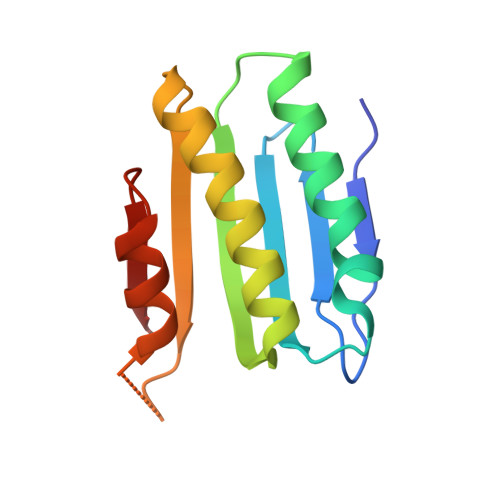The SiaABC threonine phosphorylation pathway controls biofilm formation in response to carbon availability in Pseudomonas aeruginosa.
Poh, W.H., Lin, J., Colley, B., Muller, N., Goh, B.C., Schleheck, D., El Sahili, A., Marquardt, A., Liang, Y., Kjelleberg, S., Lescar, J., Rice, S.A., Klebensberger, J.(2020) PLoS One 15: e0241019-e0241019
- PubMed: 33156827
- DOI: https://doi.org/10.1371/journal.pone.0241019
- Primary Citation of Related Structures:
6K4E, 6K4F - PubMed Abstract:
The critical role of bacterial biofilms in chronic human infections calls for novel anti-biofilm strategies targeting the regulation of biofilm development. However, the regulation of biofilm development is very complex and can include multiple, highly interconnected signal transduction/response pathways, which are incompletely understood. We demonstrated previously that in the opportunistic, human pathogen P. aeruginosa, the PP2C-like protein phosphatase SiaA and the di-guanylate cyclase SiaD control the formation of macroscopic cellular aggregates, a type of suspended biofilms, in response to surfactant stress. In this study, we demonstrate that the SiaABC proteins represent a signal response pathway that functions through a partner switch mechanism to control biofilm formation. We also demonstrate that SiaABCD functionality is dependent on carbon substrate availability for a variety of substrates, and that upon carbon starvation, SiaB mutants show impaired dispersal, in particular with the primary fermentation product ethanol. This suggests that carbon availability is at least one of the key environmental cues integrated by the SiaABCD system. Further, our biochemical, physiological and crystallographic data reveals that the phosphatase SiaA and its kinase counterpart SiaB balance the phosphorylation status of their target protein SiaC at threonine 68 (T68). Crystallographic analysis of the SiaA-PP2C domain shows that SiaA is present as a dimer. Dynamic modelling of SiaA with SiaC suggested that SiaA interacts strongly with phosphorylated SiaC and dissociates rapidly upon dephosphorylation of SiaC. Further, we show that the known phosphatase inhibitor fumonisin inhibits SiaA mediated phosphatase activity in vitro. In conclusion, the present work improves our understanding of how P. aeuruginosa integrates specific environmental conditions, such as carbon availability and surfactant stress, to regulate cellular aggregation and biofilm formation. With the biochemical and structural characterization of SiaA, initial data on the catalytic inhibition of SiaA, and the interaction between SiaA and SiaC, our study identifies promising targets for the development of biofilm-interference drugs to combat infections of this aggressive opportunistic pathogen.
- Singapore Centre for Environmental Life Sciences Engineering, Nanyang Technological University, Singapore, Singapore.
Organizational Affiliation:
















